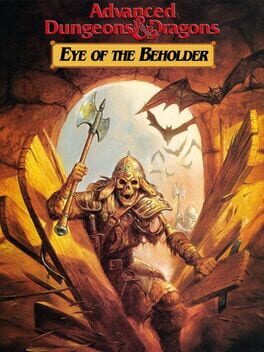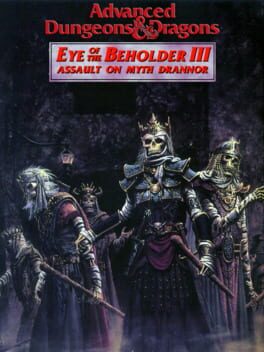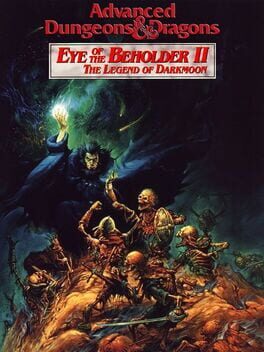

Advanced Dungeons & Dragons: Eye of the Beholder
released on Dec 31, 1991
Eye of the Beholder is an all 3-D, Legend Series computer role-playing adventure based on the popular Advanced Dungeons & Dragons 2nd Edition rules and on an original story created for this game . The action takes place in the sewers and catacombs beneath the City of Waterdeep located in TSR's Forgotten Realms game world.
Also in series
Released on
Genres
Reviews View More
Advanced Dungeons & Dragons: Eye of the Beholder is a classic dungeon crawler for the SNES. It faithfully brings the feel of D&D to the console, with grid-based movement and challenging battles against classic monsters. The graphics are simple (understandable for the era!), and it suffers from some clunky controls and punishing difficulty. Still, for old-school D&D fans and those who love a good challenge, Eye of the Beholder is a rewarding, if somewhat archaic, experience.
Está bien. Es menos frustrante de lo que parece y está relativamente bien diseñado; de hecho, es bastante difícil hacerse softlocking. También es cierto que he jugado con All-Seeing Eye, un programa externo que hace de automapa y además te puede dar pistas si quieres (y vas a querer). Creo que mi ansia de dungeon crawlers está satisfecha por el momento.
Joguei esse game pq tava sem tv (e pq tava barato na steam), nao terminei ele ainda e agora vou voltar pro Red Dead Redemption 2.
Dungeon Crawler classicasso. Não tenho muito referencial de games nesse estilo, mas imagino que hj ele deve ser bem arcaico se comparado a outros games recentes do mesmo estilo.
A versao que eu joguei na steam tem algumas funçoes novas como o mini mapa que ajuda horrores (os mapas vc tinha que fazer na mao antigamente ou olhar o mapa completo no cluebook :v) e poder ver quanto de hp tem os inimigos (pois zé, na epoca nao dava pra saber quanto que tinha, vc tinha noçao de quanto ele tinha de hp maximo se vc olhasse o manual do jogo, que alias, a estrutura dele é bem um livro do jogador de D&D).
Eu esperava que ia achar o game chato por ele ter as dungeons tudo igual, mas confesso que gostei de jogar.
O save/load come solto aqui, entao se prepara.
Futuramente eu vou voltar pra ele pra terminar.
Dungeon Crawler classicasso. Não tenho muito referencial de games nesse estilo, mas imagino que hj ele deve ser bem arcaico se comparado a outros games recentes do mesmo estilo.
A versao que eu joguei na steam tem algumas funçoes novas como o mini mapa que ajuda horrores (os mapas vc tinha que fazer na mao antigamente ou olhar o mapa completo no cluebook :v) e poder ver quanto de hp tem os inimigos (pois zé, na epoca nao dava pra saber quanto que tinha, vc tinha noçao de quanto ele tinha de hp maximo se vc olhasse o manual do jogo, que alias, a estrutura dele é bem um livro do jogador de D&D).
Eu esperava que ia achar o game chato por ele ter as dungeons tudo igual, mas confesso que gostei de jogar.
O save/load come solto aqui, entao se prepara.
Futuramente eu vou voltar pra ele pra terminar.
Dungeon crawler under the Forgotten Realms city of Waterdeep. The lords of the city hire a four person party to find the evil coming from under the city, which ends up being the beholder Xanathar. You start out trapped in the sewers and go through 12 different levels as the environment gets away from sewers to older stonework and enemies go from fighting kobolds, giant leeches, giant spiders, and Kuo-Toa to finding parties of Drow and Driders in league with Xanathar as well as more dangerous creatures like mind flayers, golems, and rust monsters.
For a 1990s PC game it both looks good and plays well enough that there is no real horribly outdated or confusing controls to get used to. The HP rolls for characters is random but in character creation it saves you the trouble from needing to make constant rerolls for a good character or for a class qualification and just allows you to set the stats to whatever you want. Fighting enemies is both automated and allow you to right click on weapons in each hand on character portraits that when used will show you either the damage they did or have miss appear before going on a brief cooldown until they can be used again. Spells are used by having a holy symbol in one of the cleric's hands or a spellbook in a mage's hand and clicking them before choosing a spell to use. You can make use of the way your party moves through the dungeon to attack an enemy and then step back or aside to avoid enemy attacks while your weapons go through their cooldowns, some enemies hitting and retreating or moving aside when they first show up is more useful as they will attack you with spells or attempt the inflict negative status effects. The rust monster near the end of the game throws something new in as you want to try to attack with ranged weapons and spells while backing away from it and keeping metal equipped fighters out of your front line. In addition to fighting enemies areas will have secret switches in walls, platforms that putting items on might activate things, areas that teleport you to another locations, portals that can teleport you to other floors, holes that will drop you to other areas, traps to avoid, walls you can walk through, and riddles and runes that can be read by certain character races.
What does hurt the game are very minor roleplay elements you have, you don't get much other than minor dealings with the clan of dwarves you find a few levels in and an option to try to bargain with a drow party. Ranged combat is done by throwing weapons or firing arrows that you then have to go pick up after every fight, the ability to recruit two other party members from NPC you find or revive in the dungeons is kind of odd when you only have two frontline slots and ranged combat is so poorly done. The thief and ranger class don't really feel like they should even be in this game, but if you wanted to take your over leveled and far overequipped party into the next game then you should probably at least take a multiclass thief. Due to the style of game the environments don't change much apart from their color palette. You find rations everywhere but food is almost pointless as clerics can cast a spell to create food and hunger is oddly measured in real time as opposed to when you rest (sometimes for days at a time) to heal and to recover spells. I used a mod that automaps the dungeons as trying to guess where I am or mapping an area out is myself is impractical (dropping certain items in game could also be done to let you know where you've been or what paths are) and that certainly makes the game feel better to play. Obviously been outdone by games like Legend of Grimrock and by its own sequel from what I hear, but not a bad start for its time. Only one save slot can be an issue if you run into a bug or just save at a very bad time.
GOG version of this comes with the trilogy and selectable options for VGA, CGA and EGA style graphics when you start the game.
Screenshots: https://twitter.com/Legolas_Katarn/status/1637721058823532545
For a 1990s PC game it both looks good and plays well enough that there is no real horribly outdated or confusing controls to get used to. The HP rolls for characters is random but in character creation it saves you the trouble from needing to make constant rerolls for a good character or for a class qualification and just allows you to set the stats to whatever you want. Fighting enemies is both automated and allow you to right click on weapons in each hand on character portraits that when used will show you either the damage they did or have miss appear before going on a brief cooldown until they can be used again. Spells are used by having a holy symbol in one of the cleric's hands or a spellbook in a mage's hand and clicking them before choosing a spell to use. You can make use of the way your party moves through the dungeon to attack an enemy and then step back or aside to avoid enemy attacks while your weapons go through their cooldowns, some enemies hitting and retreating or moving aside when they first show up is more useful as they will attack you with spells or attempt the inflict negative status effects. The rust monster near the end of the game throws something new in as you want to try to attack with ranged weapons and spells while backing away from it and keeping metal equipped fighters out of your front line. In addition to fighting enemies areas will have secret switches in walls, platforms that putting items on might activate things, areas that teleport you to another locations, portals that can teleport you to other floors, holes that will drop you to other areas, traps to avoid, walls you can walk through, and riddles and runes that can be read by certain character races.
What does hurt the game are very minor roleplay elements you have, you don't get much other than minor dealings with the clan of dwarves you find a few levels in and an option to try to bargain with a drow party. Ranged combat is done by throwing weapons or firing arrows that you then have to go pick up after every fight, the ability to recruit two other party members from NPC you find or revive in the dungeons is kind of odd when you only have two frontline slots and ranged combat is so poorly done. The thief and ranger class don't really feel like they should even be in this game, but if you wanted to take your over leveled and far overequipped party into the next game then you should probably at least take a multiclass thief. Due to the style of game the environments don't change much apart from their color palette. You find rations everywhere but food is almost pointless as clerics can cast a spell to create food and hunger is oddly measured in real time as opposed to when you rest (sometimes for days at a time) to heal and to recover spells. I used a mod that automaps the dungeons as trying to guess where I am or mapping an area out is myself is impractical (dropping certain items in game could also be done to let you know where you've been or what paths are) and that certainly makes the game feel better to play. Obviously been outdone by games like Legend of Grimrock and by its own sequel from what I hear, but not a bad start for its time. Only one save slot can be an issue if you run into a bug or just save at a very bad time.
GOG version of this comes with the trilogy and selectable options for VGA, CGA and EGA style graphics when you start the game.
Screenshots: https://twitter.com/Legolas_Katarn/status/1637721058823532545


